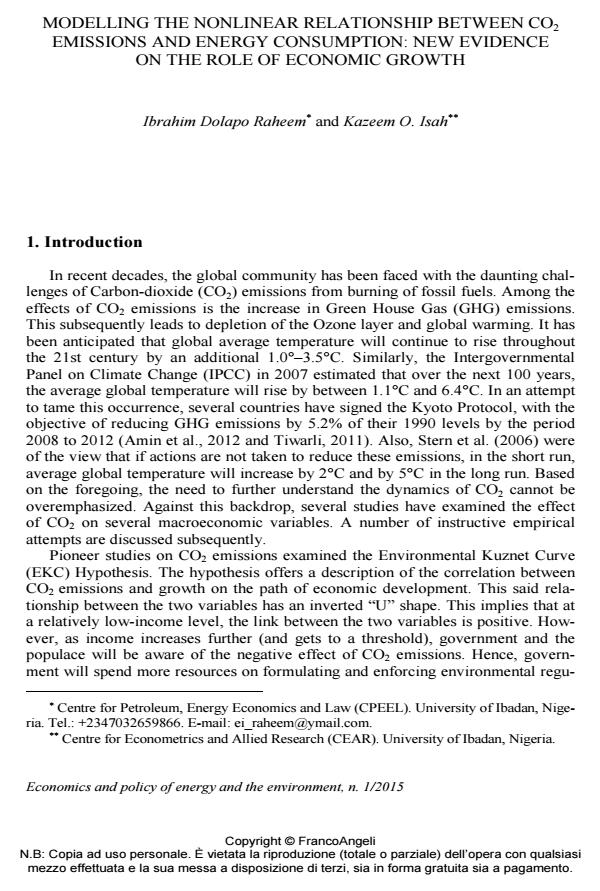Modelling the nonlinear relationship between co2 emissions and energy consumption: new evidence on the role of economic growth
Titolo Rivista ECONOMICS AND POLICY OF ENERGY AND THE ENVIRONMENT
Autori/Curatori Raheem Ibrahim Dolapo, Kazeem O. Isah
Anno di pubblicazione 2016 Fascicolo 2015/1 Lingua Inglese
Numero pagine 12 P. 59-70 Dimensione file 178 KB
DOI 10.3280/EFE2015-001005
Il DOI è il codice a barre della proprietà intellettuale: per saperne di più
clicca qui
Qui sotto puoi vedere in anteprima la prima pagina di questo articolo.
Se questo articolo ti interessa, lo puoi acquistare (e scaricare in formato pdf) seguendo le facili indicazioni per acquistare il download credit. Acquista Download Credits per scaricare questo Articolo in formato PDF

FrancoAngeli è membro della Publishers International Linking Association, Inc (PILA)associazione indipendente e non profit per facilitare (attraverso i servizi tecnologici implementati da CrossRef.org) l’accesso degli studiosi ai contenuti digitali nelle pubblicazioni professionali e scientifiche
The objective of this study is to examine the relationship between CO2 emissions and energy consumption while simultaneously accounting for the role of economic growth. Although a few recent studies have paid attention to the nonlinear relationship between the first two variables, no study that we are aware of, has considered these three variables simultaneously. Using data covering 21 countries for the period 1986-2010, the study found the existence of one threshold level of economic growth, which stood at 5.5 percent. It was also found that above this threshold level, CO2 emissions impact more on energy consumption and vice-versa. Policy implication is drawn from these results.
Keywords:Carbon dioxide emissions, economic growth, energy consumption, and dynamic panel threshold model
Jel codes:C23, O10, Q41, Q53
- Ahmad N., Iqbal A. and Mahmood H. (2012). CO2 emission, population and industrial growth linkages in selected south Asian countries: a co-integration analysis. World Applied Sciences Journal, 21 (4): 615-622. DOI: 10.5829/idosi.wasj.2013.21.4.1989
- Amin S.B., Ferdaus S.S. and Porna A.K. (2012). Causal relationship among energy use, CO2 emissions and economic growth in Bangladesh: an empirical study. World Journal of Social Science, 2: 273-290.
- Ang J.B. (2007). CO2 emissions, energy consumption, and output in France. Energy Policy, 35 (10): 4772-4778. DOI: 10.1016/j.enpol.2007.03.032
- Apergis N., Payne J.E. (2009). CO2 emissions, energy usage, and output in Central America. Energy Policy, 37: 3282-3286. DOI: 10.1016/j.enpol.2009.03.048
- Bruvoll A. and Medin H. (2003). Factors behind the environmental Kuznets curve. Environmental and Resource Economics, 24: 27-48. DOI: 10.1023/A:1022881928158
- Cherniwchan J. (2012). Economic growth, industrialization, and the environment. Resource and Energy Economics, 34: 442-467. DOI: 10.1016/j.reseneeco.2012.04.004
- Chiou-Wei S.Z., Chen C.F. and Zhu Z. (2008). Economic growth and energy consumption revisited – Evidence from linear and nonlinear Granger causality. Energy Economics, 30: 3063-3076. DOI: 10.1016/j.eneco.2008.02.002
- Cropper M. and Griffiths C. (1994). The interaction of population growth and environmental quality. American Economic Review, 84: 250-254.
- Esso L.J. (2010). Threshold cointegration and causality relationship between energy use and growth in seven African countries. Energy Economics, 32: 1383-1391. DOI: 10.1016/j.eneco.2010.08.003
- Hansen B.E. (1999). Threshold effects in non-dynamic panel: estimation, testing and inference. Journal of Econometrics, 93: 345-368. DOI: 10.1016/s0304-4076(99)00025-1
- Lantz V. and Feng Q. (2006). Assessing income, population, and technology impacts on CO2 emissions in Canada: where’s the EKC? Ecological Economics, 57: 229-238.
- Lee C.-C. and Chang C.-P. (2005), Structural breaks, energy consumption, and economic growth revisited: Evidence from Taiwan. Energy Economics, 27(6): 857-72. DOI: 10.1016/j.eneco.2005.08.003
- Lee C.-C. and Chang C.-P. (2007). The impact of energy consumption on economic growth: Evidence from linear and nonlinear models in Taiwan. Energy, 32: 2282-2294. DOI: 10.1016/j.energy.2006.01.017
- Mensah J.T. (2014). Carbon emissions, energy consumption and output: A threshold analysis on the causal dynamics in emerging African economies. Energy Policy, 70: 172-182. DOI: 10.1016/j.enpol.2014.03.038
- Öcal N. (2000). Nonlinear models for UK macroeconomic time series. Stud Nonlinear Dyn Econometrics, 4 (3): 123-135. DOI: 10.2202/1558-3708.1061
- Patel S., Pinckney T. and Jaeger W. (1995). Smallholder wood production and population pressure in East Africa: evidence of an environmental Kuznets curve? Land Economics, 71 (4): 516-533. DOI: 10.2307/3146715
- Raheem I.D. and Yussuf A.H. (2015). Energy consumption-economic growth Nexus: Evidence from linear and nonlinear models in selected African countries. International Journal on Energy Economics and Policy, 5 (2): 558-564.
- Seldon T. and Song D. (1994). Environmental quality and development: is there a Kuznets curve for air pollution emissions? Journal of Environmental Economics and Management, 27: 147-162. DOI: 10.1006/jeem.1994.1031
- Shi A. (2003). The impact of population pressure on global carbon dioxide emissions, 1975-1996: evidence from pooled cross-country data. Ecological Economics, 44: 29-42. DOI: 10.1016/s0921-8009(02)00223-9
- Stern N. (2006). The economics of climate change: the Stern review. Cambridge: Cambridge University Press.
- Tiffen M., Mortimore M. and Gichuki F. (1994). More People, Less Erosion: Environmental Recovery in Kenya. Chichester, New York: John Wiley.
- Tiwari, Aviral Kumar (2011). Energy consumption, CO2 emissions and economic growth: A Revisit of the evidence from India. Applied Econometrics and International Development, 11 (2): 1-25.
- Tong T. (1983). Threshold models in nonlinear time series analysis. New York: Springer.
- Wang K.-M. (2012). Modelling the nonlinear relationship between CO2 emissions from oil and economic growth. Economic Modelling, 29: 1537-1547. DOI: 10.1016/j.econmod.2012.05.001
- Wang Z., Shi C., Li Q. and Wang G. (2011). Impact of heavy industrialization on the carbon emissions: An empirical study of China. Energy Procedia, 5: 2610-2616. DOI: 10.1016/j.egypro.2011.03.324
- Wolde-Rufael Y. (2009). Energy demand and economic growth: the experience of African countries revisited. Energy Economics, 31: 217-224. DOI: 10.1016/j.eneco.2008.11.005
- Energy, transport, pollution and natural resources: Key elements in ecological taxation Elena Villar-Rubio, María Dolores Huete Morales, in ECONOMICS AND POLICY OF ENERGY AND THE ENVIRONMENT 1/2017 pp.111
DOI: 10.3280/EFE2016-001006
Raheem Ibrahim Dolapo, Kazeem O. Isah, Modelling the nonlinear relationship between co2 emissions and energy consumption: new evidence on the role of economic growth in "ECONOMICS AND POLICY OF ENERGY AND THE ENVIRONMENT" 1/2015, pp 59-70, DOI: 10.3280/EFE2015-001005